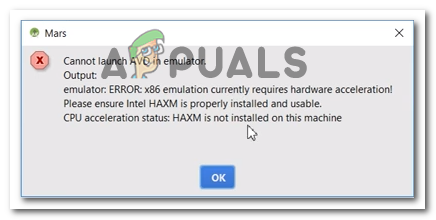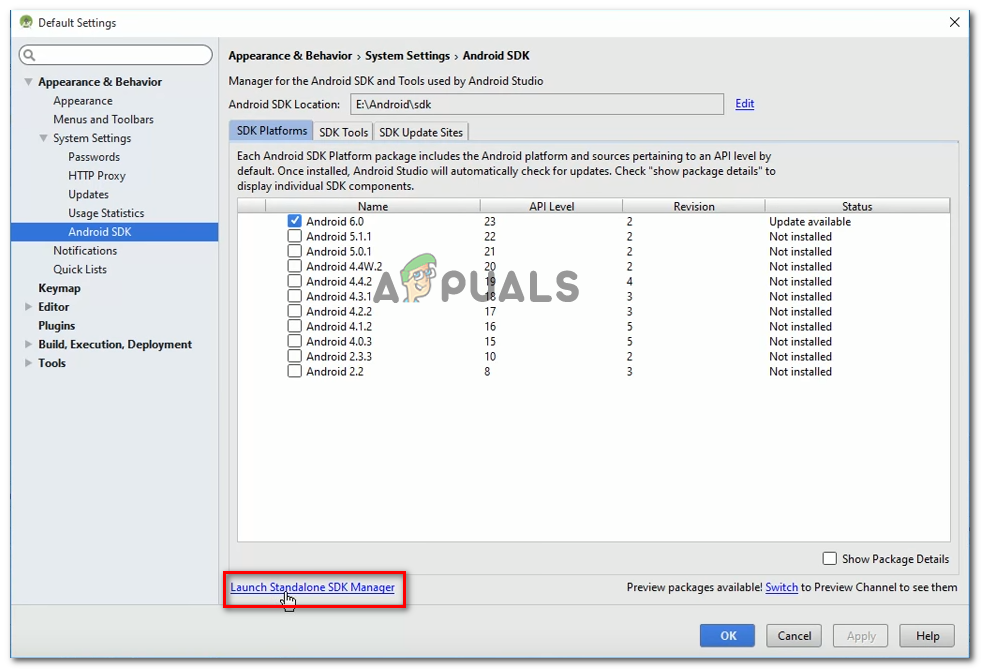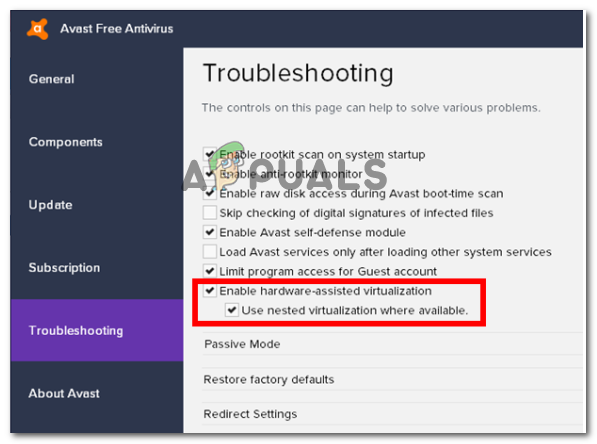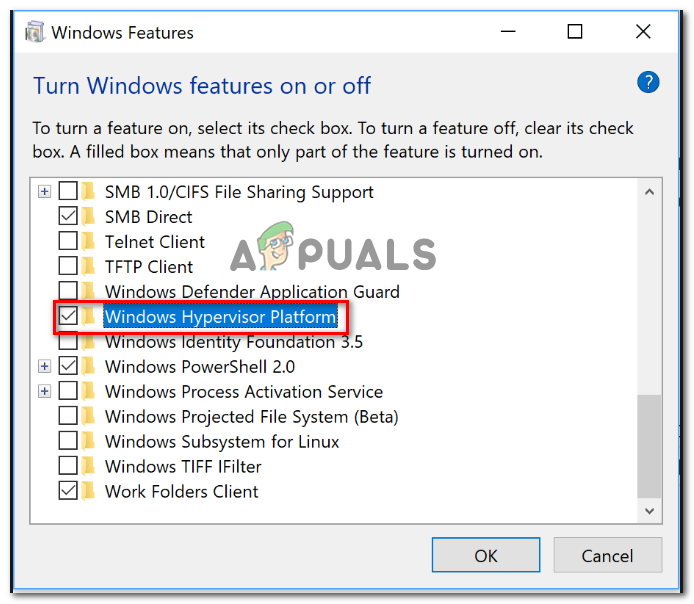Fix: x86 Emulation Currently Requires Hardware Acceleration
Some users are encountering the “x86 emulation currently requires hardware acceleration!” error when trying to launch the AVD in Android Studio. Typically, the issue occurs in a few moments after the user tries to compile an application using Android Virtual Device. The issue is not specific to a certain Android Studio build as it’s reported to occur with newer and older builds. The error is not exclusive to a certain Windows version as there are reports of it occurring on Windows 7, Windows 8 and Windows 10.

What is causing the “x86 emulation currently requires hardware acceleration!”?
We investigated this particular issue by looking at various user reports and the repair strategies that some affected users applied to get the issue resolved. Based on what we gathered, there are a few common scenarios that will trigger this particular error message:
- Intel/AMD Virtualization technology is not enabled from BIOS – This error might get thrown because your CPU is prevented from using the built-in hardware virtualization technologies by a BIOS setting. In this case, the solution is to access your BIOS settings and enable the hardware virtualization technology.
- The Intel HAXM module is not installed in Android Studio – This is one of the most common reasons why this error occurs. The installation of Intel HAXM is done in two steps ( downloading the module via the SDK manager and running the installation executable).
- A conflict between Avast’s virtualization and Android Studio’s AVD – The issue can also occur due to a well-known conflict between the built-in virtualization technology and Avast’s hardware-assisted virtualization. This 3rd party feature is also known to conflict with a number of other applications.
- Windows Hypervisor Platform is disabled for AMD CPU – Newer AMD CPUs all have hardware virtualization capabilities. But in order for the virtualization feature to work, you’ll need to ensure that the Windows Hypervisor Platform is enabled from the Windows Features screen.
- Machine’s CPU does not support hardware virtualization – This scenario might be applicable to older CPU models. If hardware virtualization is not supported by the equipped CPU, you will not be able to resolve this error message unless you replace your current CPU with a newer model.
If you’re currently struggling to resolve the “x86 emulation currently requires hardware acceleration!” error, this article will provide you with a selection of verified troubleshooting steps. Down below, you’ll discover several methods that other users struggling to resolve the same issue have used to fix or circumvent the issue.
To maintain maximum efficiency, we encourage you to follow the methods below in the order that they are presented. You should eventually stumble upon a fix that is effective in your particular scenario.
Method 1: Installing the Intel HAXM module
Before accessing the BIOS settings, let’s verify if the issue is not actually triggered by the missing of the Intel x86 Emulator Accelerator (HAXM installer). Without this module, AVD will not be able to compile applications that use hardware virtualization even if the technology is enabled on your computer.
Several users encountering the same error have reported that the issue went away for good after they downloaded the missing module via SDK Manager and installed it via the HAXM installer. Follow the steps below for complete step by step instructions:
- In Android Studio, open SDK Manager by going to Tools > Android > SDK Manager.

Launching the Standalone SDK Manager Note: You can also go to File > Settings and click on Android SDK (under System Settings). Then, simply click on Launch Standalone SDK Manager to open the built-in installation utility.
- Expand the Extras menu and check the box associated with Intel X86 Emulator Accelerator (HAXM). Then, simply click on Install Packages and wait for the procedure to complete.

Installing the Intel x86 Emulator Accelerator (HAXM installer) - Now that the HAXM installer is downloaded, we need to take the steps appropriated to install it. To do this, navigate to the following location and double-click on intelhaxm-android.exe to install it:
C:\users\%USERNAME%\AppData\Local\Android\sdk\extras\intel\Hardware_Accelerated_Execution_Manager\

Installing the intelhaxm-android.exe - Follow the on-screen prompts to install the Intel HAXM and wait for the process to complete.
- Restart Android Studio, run the application again and see if the issue has been resolved.
If you’re still encountering the “x86 emulation currently requires hardware acceleration!” error, move down to the next below.
Method 2: Disabling Hardware-assisted virtualization from Avast
If you’re using Avast as an additional security layer, the error is most likely due to a conflict caused by one of its security features. As a lot of users have reported, the hardware-assisted virtualization of Avast is known to conflict with Android Studio’s AVD, which ends up producing the “x86 emulation currently requires hardware acceleration!” error.
If this scenario is applicable to you (you have Avast installed) follow the instructions below to disable hardware-assisted virtualization from the Settings menu of the security suite:
- Open Avast and access the Settings menu,
- Inside the Settings menu, go to the Troubleshooting tab and make sure that the boxes associated with Enable hardware-assisted virtualization and Use nested virtualization where available are Unchecked.

Disable hardware-assisted virtualization inside Avast - Restart your computer and see if the conflict has been eliminated at the next startup. Run the application inside Android studio and see if the error has been resolved.
If you’re still seeing the “x86 emulation currently requires hardware acceleration!” error when running the AVD, move down to the next method below.
Method 3: Enabling Hardware Virtualization from BIOS/UEFI settings
If the first method didn’t enable you to resolve the error message, it’s likely that the error message is occurring because hardware virtualization is disabled from your BIOS/UEFI settings. Hardware virtualization should be enabled by default in normal circumstances, but manual intervention, BIOS Updates, and even some 3rd party software might disable this technology.
Keep in mind that the process of enabling hardware virtualization will be different depending on your BIOS/UEFI settings and your motherboard and CPU manufacturer.
However, the first step would be to enter your BIOS or UEFI Settings. If you have the legacy setting menu (BIOS), you’ll need to press the Setup key during the initial booting sequence. The specific setup key should appear on the initial screen, but in case you don’t spot it, you can search for it online by using the search phrase “*motherboard model + setup key*“.

If your computer uses the newer UEFI model, you will first need to access the Advanced Startup menu. To do this, press Windows key + R to open up a Run dialog box, then type “ms-settings:recovery” and press Enter to open the Recovery menu of the Settings app. Once you get there, simply click on the Restart now button under Advanced startup.

After a while, your computer will restart directly into the Advanced options menu. Once you get there, navigate to Advanced Options menu and click on UEFI Firmware Settings.

Once you’ve gained entry to your BIOS or UEFI settings, start looking for the hardware virtualization option. Depending on your BIOS/UEFI version, you’ll find this setting listed under different names. You can typically find it listed as either Virtualization technology (VTx/VTd), Intel Virtualization Technology or AMD-V Virtualization. Chances are the option will be located under Chipset, Processor, Advanced CPU Configuration or something similar.

Once you manage to enable hardware virtualization, save the BIOS/UEFI changes, restart your computer and see if the error is resolved at the next startup.
Method 4: Enabling Windows Hypervisor Platform (if applicable)
If you’re encountering the issue on an AMD CPU with virtualization technologies (newer CPU models such as Ryzen), the issue might be occured because Windows Hypervisor Platform is not enabled on your device.
But keep in mind that in order to enable this feature, you’ll need to ensure that you have Windows 10 build 1803 or older.
The Windows Hypervisor Platform can be enabled via the Turn Windows Feature On or Off screen. Here’s a quick guide on how to do this:
- Press Windows key + R to open up a Run dialog box. Then, type “appwiz.cpl” and press Enter to open the Programs & features screen.

Type appwiz.cpl and Press Enter To Open Installed Programs Page - Inside the Programs & Features page, click on Turn Windows features on or off from the left-hand pane.

Accessing the Windows Features screen - Inside the Windows Features window, check the box associated with Windows Hypervisor Platform and hit Ok to enable the feature.

Enable the Hypervisor Platform Note: While you’re no this screen, also ensure that Hyper-V is enabled. If it isn’t, enable it by checking the box associated with it.
- Restart your computer and see if the error has been resolved.





